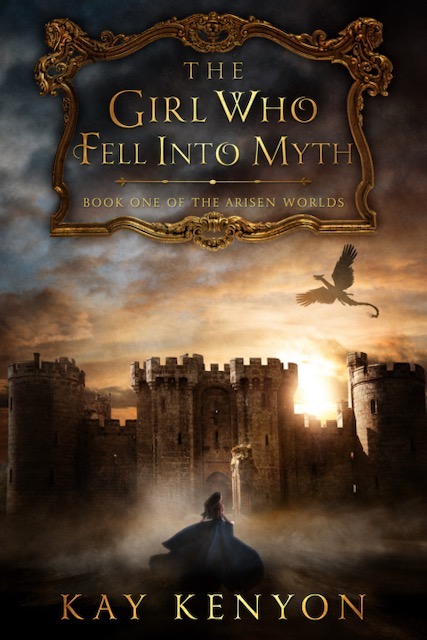
Kay Kenyon is joining us today to talk about her novel, The Girl Who Fell Into Myth. Here’s the publisher’s description:
Yevliesza has been caring for her ailing father when she is summoned home to a world she has never seen. Using a hidden portal, she enters the realm of Numinat, a myth world arisen from legend. Although she is the daughter of witches, she was raised in the modern age with little knowledge of their arisen world and none of their magic.
For the the last leg of her journey, she flies on the back of a dragon. When a storm splits open the sky, Yevliesza is caught in its blinding light. She arrives at the medieval city-palace severely damaged, indelibly marked as an outsider.
In this kingdom of deep powers, she is devoid of magic. Determined to find her power and claim her place, she must counter dangerous court intrigues and a sorceress who intends to see this foreigner cast from the great Tower.
Yevliesza may find protection with a powerful lord if her heart can bear the penalty of his conditions. In the end, however, she must find her own path if she is to survive. But what she discovers is an alarming magic that, once revealed, may make her a permanent outcast.
What’s Kay’s favorite bit?

Kay Kenyon
Sometimes a small world-building detail prompts a deeper dive into milieu and character. That happened with my new book, The Girl Who Fell Into Myth, when I was defining the elements of magic. I wanted the magical powers to be specific and limited, so I began to list them. I knew there would be powers related to creatures, verdure, and elements, for instance, and I came up with eight that I thought suited the Mythos, the worlds within worlds that comprise the setting of this series.
But eight powers were wrong. Nine would be better because I had it stuck in my mind that even numbers were bad luck to the hide bound Numinasi, who live in the realm of Numinat, the main kingdom of book one. (Although we also enter the realm of the elven—called Alfan Sih in my story.)
That’s when I thought of ley lines.
Not the straight lines drawn between landmarks that may have been recognized by ancient societies—but actual, powerful streams of magic—mysterious, ever-present, and visible to those with the ability of what I term aligns.
In one scene some of my characters notice these streams of power while they are on a journey.
They crossed aligns that appeared like long-vanished rivers, creases in the land, filled with glittering, molten light as though a buried sun sent its brilliance through the fissures.
Then that world-building detail drew me further in. How would the presence of these magic-filled fissures affect the culture? After all, aligns would be the only power that was in the land, a part of the geography, known by all in a general way, and seen, perceived, and manipulated by those who had align power. And because they were a feature of the landscape, aligns would hold a special place in Numinasi imagination. Aligns would be a powerful symbol of their fundamental selves. As Valenty, the ambiguous Numinasi lord, tells Yevliesza (the name my major character adopts in the Mythos): “What runs through the rocks of the land runs through the bones of the Numinasi.” Magic isn’t just what they do. It’s who they are.
This idea ties directly into the plot and became the cultural basis for Yevliesza’s challenges in the Numinat.
Numinat is half-matriarchal. Historically, women and men found it hard to live peaceably together. Then they devised the idea that women would control the politics while the men would dominate the military. More power rests with women than with men. Therefore, in this medieval setting, the plot obstacles for my female protagonist don’t arise from male privilege.
The obstacles Yevliesza must overcome arise from other cultural aspects. The Numinasi have an almost fanatical distrust of foreign influences. So, when a woman of Earth comes into their midst, she is automatically an outsider. But then she is doubly suspect since she happens to be the daughter of a Numinasi, and it works out that, being born on Earth, she has no deep powers. A Numinasi without powers has never been seen before, and by many she is therefore considered fundamentally flawed.
This situation is the basis for the cultural clashes that became deep currents of the book, always keeping Yevliesza off-balance; Valenty struggling to navigate; the antagonist, Nashavety, fighting against change; and the princip—the queen—in danger of losing her crown.
I followed this idea into a rabbit-hole, becoming increasingly committed as I watched it unfold. Aligns wasn’t the biggest piece of world-building that I did, but it’s one I love because it is both physical and cultural, and I got to write, “creases in the land, filled with glittering, molten light.”
And it was even true.
LINKS:
The Girl Who Fell Into Myth universal book link
BIO:
Kay Kenyon is the author of sixteen fantasy and science fiction novels and two short story collections. Her work has been shortlisted for the Philip K. Dick award, the John W. Campbell Memorial award, The Endeavour Award, and the American Library Reading List award. Her most recent work is The Girl Who Fell Into Myth, book one of a new fantasy series, The Arisen Worlds. A previous series, The Dark Talents, has been optioned for film. She is a founding member of the Write on the River organization for aspiring writers in Eastern Washington through which she runs a bi-monthly online chat called “Boost Your Writing Chops.” Follow her on Facebook and Goodreads or visit her website at kaykenyon.com.
